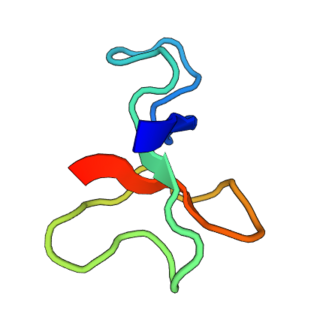Related Research Articles

Delta atracotoxin is a low-molecular-weight neurotoxic polypeptide found in the venom of the Sydney funnel-web spider.
Bestoxin is a neurotoxin from the venom of the South African spitting scorpion Parabuthus transvaalicus. Most likely, it targets sodium channel function, thus promoting spontaneous and repetitive neuronal firing. Following injection into mice, it causes non-lethal writhing behaviour.
AETX refers to a group of polypeptide neurotoxins isolated from the sea anemone Anemonia erythraea that target ion channels, altering their function. Four subtypes have been identified: AETX I, II, III and K, which vary in their structure and target.
Bukatoxin is an α-scorpion toxin found in the venom of the Chinese scorpion Buthus martensi Karsch. By blocking the inactivation of sodium ion channels, α-scorpion toxins prolong action potentials.
Huwentoxins (HWTX) are a group of neurotoxic peptides found in the venom of the Chinese bird spider Haplopelma schmidti. The species was formerly known as Haplopelma huwenum, Ornithoctonus huwena and Selenocosmia huwena. While structural similarity can be found among several of these toxins, HWTX as a group possess high functional diversity.
Calitoxin, also known as CLX, is a sea anemone neurotoxin produced by the sea anemone Calliactis parasitica. It targets crabs and octopuses, among other invertebrates. Two isoforms have been identified, both of which are formed from precursors stored in the stinging cells of the anemone. Once the toxin is activated and released, it causes paralysis by increasing neurotransmitter release at invertebrate neuromuscular junctions. Along with several other toxins derived from anemones, CLX is useful in ion channel research. Certain structural aspects of calitoxin are dissimilar from sea anemone toxins that also target the sodium ion channels. Other toxins resembling calitoxin function in completely different ways.
Cangitoxin, also known as CGTX or CGX, is a toxin purified from the venom of the sea anemone Bunodosoma cangicum, which most likely acts by prolonging the inactivation of voltage-gated sodium channels.
CgNa is a peptide toxin isolated from the sea anemone Condylactis gigantea. It causes an increased action potential duration by slowing down the inactivation of tetrodotoxin-sensitive sodium channels.
Kaliseptine (AsKS) is a neurotoxin which can be found in the snakelocks anemone Anemonia viridis. It belongs to a class of sea anemone neurotoxins that inhibits voltage-gated potassium channels.
LmαTX3 is an α-scorpion toxin from Lychas mucronatus. that inhibits fast inactivation of voltage gated sodium-channels (VGSCs).
Kalicludine (AsKC) is a blocker of the voltage-dependent potassium channel Kv1.2 found in the snakeslocks anemone Anemonia viridis, which it uses to paralyse prey.

BcIII is a polypeptide sea anemone neurotoxin isolated from Bunodosoma caissarum. It targets the site 3 of voltage-gated sodium channels, thus mainly prolonging the inactivation time course of the channel.
ATX-II, also known as neurotoxin 2, Av2, Anemonia viridis toxin 2 or δ-AITX-Avd1c, is a neurotoxin derived from the venom of the sea anemone Anemonia sulcata. ATX-II slows down the inactivation of different voltage-gated sodium channels, including Nav1.1 and Nav1.2, thus prolonging action potentials.
APETx1 is a peptide toxin from the venom of the sea anemone Anthopleura elegantissima. The toxin acts as a gating modifier on the human ether-à-go-go-related gene (hERG) channel, a type of voltage-gated potassium channel, and as a blocker of voltage-gated sodium channels, including Nav1.2 and Nav1.8.
Beta-mammal toxin Cn2, also known as Cn2 toxin, is a single chain β-scorpion neurotoxic peptide and the primary toxin in the venom of the Centruroides noxius Hoffmann scorpion. The toxin specifically targets mammalian Nav1.6 voltage-gated sodium channels (VGSC).
Neurotoxin B-IV is a venom peptide secreted by a large marine worm called Cerebratulus lacteus that inhabits the northeastern coast of North America. This neurotoxin belongs to a major type of B polypeptide neurotoxins, which appear to be selectively toxic for crustaceans. The mode of action for neurotoxin B-IV has not been clearly established. However, it is likely that B neurotoxins prolong the repolarization phase of action potentials by interacting with voltage-gated sodium channels.
LmαTX5 is an α-scorpion toxin which inhibits the fast inactivation of voltage-gated sodium channels. It has been identified through transcriptome analysis of the venom gland of Lychas mucronatus, also known as the Chinese swimming scorpion – a scorpion species which is widely distributed in Southeast Asia.

Delta hexatoxin Hv1 is a neurotoxic component found in the venom of the Australian funnel web spider.
Kunitz-type serine protease inhibitor APEKTx1 is a peptide toxin derived from the sea anemone Anthopleura elegantissima. This toxin has a dual function, acting both as a serine protease inhibitor and as a selective and potent pore blocker of Kv1.1, a shaker related voltage-gated potassium channel.

RTX-III (neurotoxin-III,δ-SHTX-Hcr1a) is a neurotoxin peptide derived from the Sebae anemone Radianthus crispa. The toxin targets voltage-dependent sodium channels by preventing its complete inactivation, which can lead to a prolonged influx of sodium ions and depolarization of the cell's membrane.
References
- 1 2 3 4 5 6 7 8 9 Ishida, M (Apr 1997). "Halcurin, a polypeptide toxin in the sea anemone Halcurias sp., with a structural resemblance to type 1 and 2 toxins". Toxicon. 35 (4): 537–544. doi:10.1016/s0041-0101(96)00143-2. PMID 9133708.
- 1 2 3 Bosmans, F (Dec 2002). "The sea anemone Bunodosoma granulifera contains surprisingly efficacious and potent insect-selective toxins". FEBS. 532 (1–2): 131–134. Bibcode:2002FEBSL.532..131B. doi: 10.1016/s0014-5793(02)03653-0 . PMID 12459477.
- 1 2 Norton, RS (1991). "Structure and structure-function relationships of sea anemone proteins that interact with the sodium channel". Toxicon. 29 (9): 1051–1084. Bibcode:1991Txcn...29.1051N. doi:10.1016/0041-0101(91)90205-6. PMID 1686683.
- ↑ Honma, Tomohiro; Shiomi, Kazuo (2006). "Peptide Toxins in Sea Anemones: Structural and Functional Aspects". Marine Biotechnology. 8 (1): 1–10. Bibcode:2006MarBt...8....1H. doi:10.1007/s10126-005-5093-2. PMC 4271777 . PMID 16372161.
- ↑ Caterall, WA (1995). "Structure and function of voltage-gated ion channels". Annual Review of Biochemistry. 64: 493–531. doi:10.1146/annurev.bi.64.070195.002425. PMID 7574491.
- ↑ Rogers, JC (Jul 1996). "Molecular determinants of high affinity binding of alpha-scorpion toxin and sea anemone toxin in the S3-S4 extracellular loop in domain IV of the Na+ channel alpha subunit". Journal of Biological Chemistry. 271 (27): 15950–15962. doi: 10.1074/jbc.271.27.15950 . PMID 8663157.